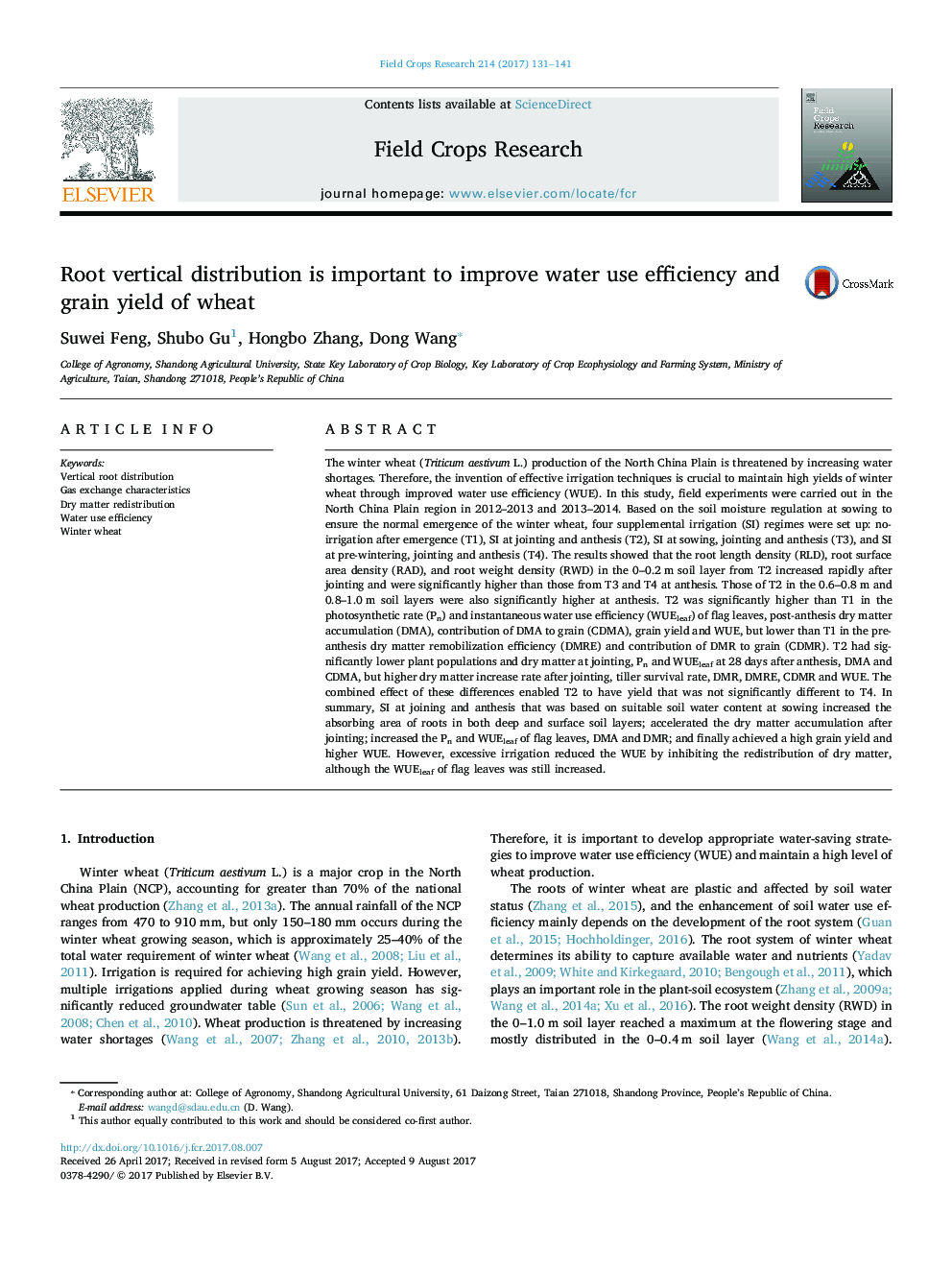| کد مقاله | کد نشریه | سال انتشار | مقاله انگلیسی | نسخه تمام متن |
|---|---|---|---|---|
| 5761378 | 1624649 | 2017 | 11 صفحه PDF | دانلود رایگان |
عنوان انگلیسی مقاله ISI
Root vertical distribution is important to improve water use efficiency and grain yield of wheat
ترجمه فارسی عنوان
توزیع عمودی ریشه برای بهبود بهره وری استفاده از آب و عملکرد دانه گندم مهم است
دانلود مقاله + سفارش ترجمه
دانلود مقاله ISI انگلیسی
رایگان برای ایرانیان
کلمات کلیدی
توزیع ریشه عمودی، ویژگی های تبادل گاز، توزیع ماده خشک، بهره وری استفاده از آب، گندم زمستانه،
موضوعات مرتبط
علوم زیستی و بیوفناوری
علوم کشاورزی و بیولوژیک
علوم زراعت و اصلاح نباتات
چکیده انگلیسی
The winter wheat (Triticum aestivum L.) production of the North China Plain is threatened by increasing water shortages. Therefore, the invention of effective irrigation techniques is crucial to maintain high yields of winter wheat through improved water use efficiency (WUE). In this study, field experiments were carried out in the North China Plain region in 2012-2013 and 2013-2014. Based on the soil moisture regulation at sowing to ensure the normal emergence of the winter wheat, four supplemental irrigation (SI) regimes were set up: no-irrigation after emergence (T1), SI at jointing and anthesis (T2), SI at sowing, jointing and anthesis (T3), and SI at pre-wintering, jointing and anthesis (T4). The results showed that the root length density (RLD), root surface area density (RAD), and root weight density (RWD) in the 0-0.2Â m soil layer from T2 increased rapidly after jointing and were significantly higher than those from T3 and T4 at anthesis. Those of T2 in the 0.6-0.8Â m and 0.8-1.0Â m soil layers were also significantly higher at anthesis. T2 was significantly higher than T1 in the photosynthetic rate (Pn) and instantaneous water use efficiency (WUEleaf) of flag leaves, post-anthesis dry matter accumulation (DMA), contribution of DMA to grain (CDMA), grain yield and WUE, but lower than T1 in the pre-anthesis dry matter remobilization efficiency (DMRE) and contribution of DMR to grain (CDMR). T2 had significantly lower plant populations and dry matter at jointing, Pn and WUEleaf at 28Â days after anthesis, DMA and CDMA, but higher dry matter increase rate after jointing, tiller survival rate, DMR, DMRE, CDMR and WUE. The combined effect of these differences enabled T2 to have yield that was not significantly different to T4. In summary, SI at joining and anthesis that was based on suitable soil water content at sowing increased the absorbing area of roots in both deep and surface soil layers; accelerated the dry matter accumulation after jointing; increased the Pn and WUEleaf of flag leaves, DMA and DMR; and finally achieved a high grain yield and higher WUE. However, excessive irrigation reduced the WUE by inhibiting the redistribution of dry matter, although the WUEleaf of flag leaves was still increased.
ناشر
Database: Elsevier - ScienceDirect (ساینس دایرکت)
Journal: Field Crops Research - Volume 214, December 2017, Pages 131-141
Journal: Field Crops Research - Volume 214, December 2017, Pages 131-141
نویسندگان
Suwei Feng, Shubo Gu, Hongbo Zhang, Dong Wang,
